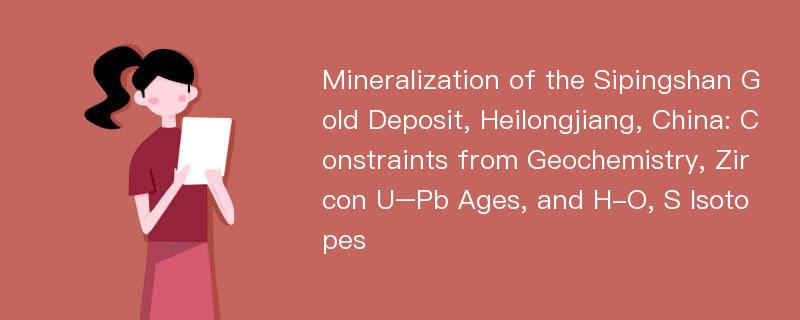
论文摘要
The Sipingshan gold deposit at Heilongjiang, China, is located in the Wandashan epicontinental accretional terrane. Two major stages of mineralization and alteration can be identified in the deposit(Wang, 2014). In the earlier stage, gold was precipitated in chert and silicified breccias and silicified rhyolitic porphyry, which produced layered orebodies. The later and lower irregular, vein–stockwork orebodies crosscut the older orebearing rocks along fractures. The cherts have relatively high Al2O3, K2O, and Na2O contents, and show a positive correlation between TiO2 and Al2O3, K2O+Na2O and Al2O3. Combined with the geological characteristics and geochemical diagrams, this indicates that the Sipingshan ore-bearing cherts formed by hydrothermal sedimentation in the intra-continental portion, where was controlled by the continental margin setting. The δ34S values(–12.4‰ to 29.7‰) of pyrite, and δ18O(6.5‰ to 12.6‰) and δD(–84‰ to –182.5‰) values of fluids, indicate that the dominant component of the ore-forming fluid was circulating meteoric water. The ore-forming materials were derived from different sources. A newly discovered mineralized granite porphyry in drill core shows a close spatial-temporal relationship with the orebodies and identified as the parent rock of the Sipingshan gold deposit. The granite porphyry yielded a U–Pb zircon ageof 113.5 ± 0.7 Ma, which is slightly older than the ore-forming age of the Sipingshan gold deposit. The granite porphyry has high SiO2 and K2O, low Al2O3, consistent with it being analuminous A-type granite formed in an extensional setting related to the westward subduction of the Paleo-Pacific Plate(Wu et al., 2011; Xu et al., 2013; Wang et al., 2019). The heating from the granitic magma on the overlying stratas resulted in the temperature and pressure gradient. Meteoric water percolating downward along faults in the shallow crust was driven and migrated upward to forming a fluid circulation system. In the process, the circulating fluid continually extracted ore-forming elements from the surrounding rocks to form the gold-bearing fluid. Subsequently, the ore-bearing fluid was discharged at the surface and rapidly cooled by the surrounding terrestrial water, and resulting in the precipitation of Au and Ag to form layered orebodies, and the later stage fluids filled fractures and weak zones in the upper strata to form the veinstockwork mineralization.
论文目录
文章来源
类型: 国际会议
作者: WANG Shuo,SUN Fengyue,WANG Guan,LIU Kai,GUO Huali
来源: 第九届世界华人地质科学研讨会 2019-06-01
年度: 2019
分类: 基础科学,工程科技Ⅰ辑
专业: 地质学,矿业工程
单位: School of Earth Sciences and Resource, Chang’an UniversityCollege of Earth Sciences, Jilin UniversitySchool of Mining Engineering, Heilongjiang University of Science & TechnologyShenyang Centerof Geological Survey,China geological SurveyShaanxi Geological Exporation Institute of China Chemical Geology and Mine Bureau
分类号: P618.51
DOI: 10.26914/c.cnkihy.2019.028352
页码: 135-136
总页数: 2
文件大小: 210k
下载量: 2
